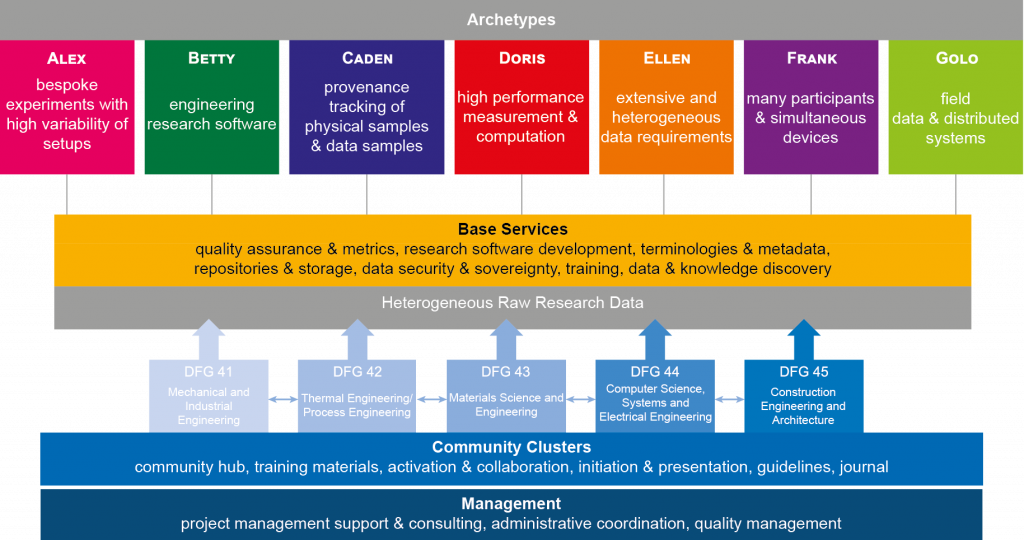Welcome to NFDI4Ing – the National Research Data Infrastructure for Engineering Sciences!
Our Mission
As part of the German National Research Data Infrastructure (NFDI), the consortium aims to develop, disseminate, standardise and provide methods and services to make engineering research data FAIR: data has to be findable, accessible, interoperable, and re-usable.
Engineering sciences play a key role in developing solutions for the technical, environmental, and economic challenges imposed by the demands of our modern society. The associated research processes as well as the solutions themselves can only be sustainable if it is accompanied by proper research data management (RDM) that implements the FAIR data principles first outlined in 2016. NFDI4Ing brings together the engineering communities to work towards that goal.
Engineering communities share a number of similarities: they typically show a high affinity and ability to develop and adapt IT systems, familiarity with standardisation (e.g. industry standards), know-how in quality management, and last but not least an established practice of systematic approaches in big projects with many stakeholders. However, the engineering sciences are also highly specialised, with a large number of (sub-)communities that range from architecture and civil engineering all the way to process engineering and thermal engineering. Depending on the research subjects, engineers work with a diverse set of types, objects, amount, and quality of data. Not surprisingly, this results in a wide variety of engineering research profiles and often highly specialised approaches towards research data management.
Our mission as NFDI4Ing is to develop research data management solutions that benefit the engineering community at large.
Our Goals
From its inception, NFDI4Ing focused on eight objectives that were identified in close collaboration with the engineering communities. Beginning back in 2017, we conducted surveys, workshops and semi-standardised face-to-face interviews with representatives from engineering research communities. The results provided a broad overview of the then current state and needs regarding RDM in engineering sciences. From this basis, we developed the eight key objectives shown below.
Retrace & Reproduce
Scientists of all disciplines are able to retrace or reproduce all steps of engineering research processes. This ensures the trustworthiness of published results, prevents redundancies, and contributes to social acceptance.
Research Software
Scientists of all disciplines are able to retrace or reproduce all steps of engineering research processes. This ensures the trustworthiness of published results, prevents redundancies, and contributes to social acceptance.
Auxiliary Information
Scientists of all disciplines are able to retrace or reproduce all steps of engineering research processes. This ensures the trustworthiness of published results, prevents redundancies, and contributes to social acceptance.
Sharing & Integration
Scientists of all disciplines are able to retrace or reproduce all steps of engineering research processes. This ensures the trustworthiness of published results, prevents redundancies, and contributes to social acceptance.
Authorised Access
Scientists of all disciplines are able to retrace or reproduce all steps of engineering research processes. This ensures the trustworthiness of published results, prevents redundancies, and contributes to social acceptance.
Machine Readability
Scientists of all disciplines are able to retrace or reproduce all steps of engineering research processes. This ensures the trustworthiness of published results, prevents redundancies, and contributes to social acceptance.
Data Literacy
Engineers profit from an improved data- and software-related education (data literacy) and available domain and application specific best practices.
Data Publications
Our Structure
The objectives above take into account perspectives of engineers as well as infrastructure providers and instructed the structure of NFDI4Ing. As a project, NFDI4Ing is sub-divided into different task areas. At the centre are the seven task areas focused on addressing the requirements of our Archetypes. The archetypes are methodically derived attempts to cluster typical engineering research methods and workflows and classify corresponding challenges in RDM. The archetype task areas are flanked by our Community Clusters that connect them to the engineering communities, and the Base Services that further develop and scale solutions provided by the archetypes and supply specific services and tools for internal and external partners.
To illustrate the purpose of each task area, we commonly draw on similarities to the structure of a company. The archetypes are roughly similar to the R&D department of an enterprise, tasked with innovating and developing solutions to customer requirements. The Base Services correspond to manufacturing and production, picking up the raw solutions from the archetypes and bringing them to market. The Community Clusters represent marketing and public relations, being closely connected to all relevant stakeholders and acting as go-between between the consortium and its environment.
You can see more details the individual task areas in the diagram below.

Overview of the structure and work programme of NFDI4Ing
